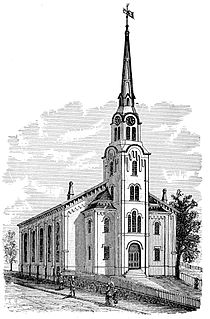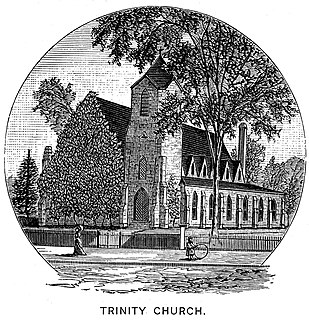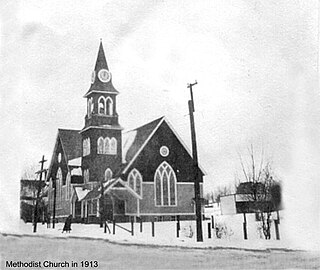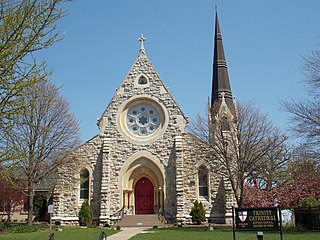
The First Baptist Church in America is the First Baptist Church of Providence, Rhode Island, also known as the First Baptist Meetinghouse. It is the oldest Baptist church congregation in the United States, founded in 1638 by Roger Williams in Providence, Rhode Island. The present church building was erected in 1774–75 and held its first meetings in May 1775. It is located at 75 North Main Street in Providence's College Hill neighborhood. It was designated a National Historic Landmark in 1960.

Dexter Avenue Baptist Church is a Baptist church in Montgomery, Alabama, United States, affiliated with the Progressive National Baptist Convention. The church was designated as a National Historic Landmark in 1974 because of its importance in the civil rights movement and American history. In 1978 the official name was changed to the Dexter Avenue King Memorial Baptist Church, in memory of Dr. Martin Luther King Jr., who was pastor there and helped organize the Montgomery bus boycott in 1955 during the civil rights era. The church is located steps away from the Alabama State Capitol.

St. Peter's Evangelical Lutheran Church, or Iglesia Luterana San Pedro, is a historic church complex located in the Walker's Point neighborhood of Milwaukee, Wisconsin. Its buildings are listed on the National Register of Historic Places.

The First Presbyterian Church of Chester is a Presbyterian church in Chester. It is located along NY 94 in the eponymous village in Orange County, New York, United States. The current church building, listed on the National Register of Historic Places in 1998, is the third in the history of the congregation, on as many locations. Two additions have been built but the building otherwise remains intact, a well-preserved example of a 19th-century rural American church.

The Stevensville Historic District, also known as Historic Stevensville, is a national historic district in downtown Stevensville, Queen Anne's County, Maryland. It contains roughly 100 historic structures, and is listed on the National Register of Historic Places. It is located primarily along East Main Street, a portion of Love Point Road, and a former section of Cockey Lane.

The Warren United Methodist Church and Parsonage are a Methodist church and house at 27 Church Street in the center of Warren, Rhode Island. The church was started in 1789 under the Rev. Daniel Smith and was the first Methodist congregation in Rhode Island. The building is a Greek Revival structure with a full temple front built in 1844 by Fall River, Massachusetts architect Perez Mason. The parsonage is a two-story Italianate structure built by the congregation in 1858. It was designed by the Warren firm of Hoar & Drown and built by the related firm of Hoar & Martin.

Central Falls Congregational Church is an historic church located in Central Falls, Rhode Island. This Shingle style wood frame structure was built in 1883 to serve a local Congregationalist congregation which was established in 1820 and had outgrown its previous space. Among the members of this church was wadding mill industrialist and Lieutenant governor of Rhode Island Henry A. Stearns.

The Pawtucket Congregational Church is an historic church building at 40 and 56 Walcott Street, at the junction of Broadway and Walcott St., in the Quality Hill neighborhood of Pawtucket, Rhode Island.

Trinity Episcopal Church was a historic church located at 48 Main Street in Pawtucket, Rhode Island. Built by the Episcopalians, the building was sold to the Catholics in 1977 and became the St. George Maronite Catholic Church within the Diocese of Providence. The church burned down in 2005, and was not rebuilt.

The First Congregational Church and Parsonage is a historic church complex at 23 Pepperrell Road in the Kittery Point section of Kittery, Maine. Built in 1730 for a congregation first organized in 1653, the church is the oldest in Kittery, and one of the oldest in the state of Maine. It is accompanied by a parsonage house, built in 1729, and a small cemetery, established in 1733. The buildings were listed on the National Register of Historic Places in 1978; the cemetery was added to the listing in 1997.

The Gray Memorial United Methodist Church and Parsonage is a historic church complex at 8 Prospect Street in Caribou, Maine. The Gothic Revival wood frame church, built in 1912-14 for a Methodist congregation founded in 1860, is the most architecturally sophisticated church in Caribou. It was built on the lot of the Colonial Revival parsonage house, which was moved to make way for the church. The complex was listed on the National Register of Historic Places in 1995. The current pastor is Rev. Timothy Wilcox.

Buckland is a rural locality in the local government area (LGA) of Glamorgan–Spring Bay in the South-east LGA region of Tasmania. The locality is about 25 kilometres (16 mi) south-west of the town of Triabunna. The 2016 census has a population of 179 for the state suburb of Buckland. It is a village on the Tasman Highway in Tasmania, Australia. It contains a historic church, St John the Baptist church.

Trinity Episcopal Cathedral, formerly known as Grace Cathedral, is the historic cathedral in the Diocese of Iowa. The cathedral is located on the bluff overlooking Downtown Davenport, Iowa, United States. Completed in 1873, Trinity is one of the oldest cathedrals in the Episcopal Church in the United States. It was individually listed on the National Register of Historic Places in 1974. In 1983 the cathedral was included as a contributing property in the College Square Historic District, which is also listed on the National Register.

The Mechanicsburg Baptist Church is a historic church in the village of Mechanicsburg, Ohio, United States. Constructed for a Methodist congregation in the late nineteenth century, the building was taken over by Baptists after the original occupants vacated it, and it has been named a historic site.

St. Paul's Episcopal Church is a parish church in the Diocese of Iowa. The church is located in Durant, Iowa, United States. The church building and parish hall have been listed on the National Register of Historic Places since 1985.

German Evangelical Reformed Church, also known as the Zoar Church, is a historic church located north of Newton, Iowa, United States. The congregation was established in 1876 by German immigrants, many of whom settled here in the late 1860s after first living in Freeport, Illinois. They built a small frame church on this property soon after, and the first burial in the cemetery behind the church building occurred in 1877. The present frame church was built by members of the congregation in 1892. It features a bell tower in the northeast corner, a gable roof, and a rock-faced stone foundation. Both the gablets on the tower and the front gable feature scalloped shingling. The entryway on the west side of the church was added in 1961. The house to the east of the church was the parsonage, which was sold in 1957. The church and cemetery were listed on the National Register of Historic Places in 1979.

Christ Episcopal Church, or simply Christ Church, is an historic church building located in Burlington, Iowa, United States. It is a part of the Episcopal Diocese of Iowa, and is a contributing property in the Heritage Hill Historic District listed on the National Register of Historic Places.

St. John's Lutheran Church is located in rural Franklin County, Iowa, United States, east of the city of Hampton. The church property was listed as a historic district on the National Register of Historic Places as St. John's Danish Evangelical Lutheran Church in 2015. At the time of its nomination it contained ten resources, which included five contributing buildings, two contributing sites, one contributing structure, one contributing object, and one non-contributing structure.

The Community Baptist Church and Parsonage are a historic church property at 2 and 10 Mountain Road in the center of Montgomery, Vermont. The church, built in 1866, is a prominently placed example of Greek Revival architecture, while the adjacent parsonage house is a well-preserved example of the Colonial Revival. The church was for many years a center of social activities in the town, prior to its closure in 2011. It was listed on the National Register of Historic Places in 2015.






















